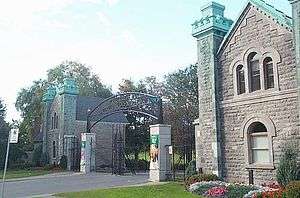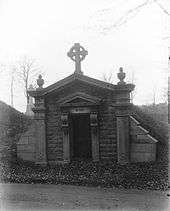Notre Dame des Neiges Cemetery
|
Front entrance, Cimetière Notre-Dame-des-Neiges | |
| Details | |
|---|---|
| Established | 1854 |
| Location | Montreal, Quebec |
| Country | Canada |
| Type | originally Roman Catholic, open to Christian burials |
| Size | 343 acres (139 ha) |
| Number of graves | 65,000+ |
| Number of interments | 1 million |
| Website | Official website |
| Designated | 1999 |
Founded in 1854, Cimetière Notre-Dame-des-Neiges is a 343-acre (139 ha) cemetery located in the borough of Côte-des-Neiges-Notre-Dame-de-Grâce, Montreal, Quebec, Canada. The entrance and the grounds run along a part of Côte-des-Neiges road and up the slopes of Mount Royal. Notre-Dame-des-Neiges Cemetery is the largest cemetery in Canada and the third-largest in North America.[1]
History and description
Created on property purchased from Dr. Pierre Beaubien, the new cemetery was a response to growing demand at a time when the old Saint-Antoine Cemetery (near the present Dominion Square) had become too small to serve Montreal’s rapidly increasing population.[2] On May 29, 1855, Mrs. Jane Gilroy, wife of Thomas McCready, then a Montreal municipal councilor, was the first person to be buried in the new cemetery.[3]
Notre-Dame-des-Neiges is the largest cemetery in Canada with more than 55 kilometres of lanes and one million people interred.[4] The Notre-Dame-des-Neiges Cemetery site has over 65,000 monuments and 71 family vaults.[5]
The cemetery was originally open only to Roman Catholics; it is now open to any Christian, though it continues to be a Catholic institution and serve a primarily Catholic community. Primarily the interment grounds for French Canadians, as they have almost exclusively been members of the Roman Catholic faith.The cemetery shares the mountain with the predominantly English-speaking and originally Protestant adjacent burial ground, the Mount Royal Cemetery. These two abutting cemeteries on the slopes of Mount Royal contain a total of 1.5 million burials.
"La Pietà Mausoleum" contains a life-sized marble reproduction of Michelangelo's Pietà sculpture (original located in St. Peter's Basilica at the Vatican). Notre-Dame-des-Neiges Cemetery was designated a National Historic Site of Canada in 1999 and plaqued in 2004.[6][7]
No burials or cremations took place between May 16, 2007, and September 11, 2007, because of a labour strike. The interments of more than 300 bodies were affected.[8] In addition, its uncut, unkempt grass became a symbol of the labour dispute.
Due to its vast size, locating a specific grave can be difficult. As a result, the cemetery now offers a computerized mapping service that allows visitors to quickly and accurately locate graves. It can be accessed at the cemetery using a touch screen display or via the Internet.[4]
War Graves
The only opening in the fence between the Notre Dame des Neiges and Mount Royal cemeteries is where two adjoining military sections are. Shortly after World War I, to emphasize the comradeship and uniformity of sacrifice of Protestant and Catholic soldiers, the Imperial War Graves Commission insisted on an open passage between the two plots and the Cross of Sacrifice was erected.[9] There are 445 Commonwealth service war grave burials commemorated here, 252 from World War I and 215 from World War II. Those whose graves could not be individually marked are named on bronze plaques attached to the Cross of Sacrifice. The Quebec Memorial on the National Field of Honour at Pointe-Claire lists 24 servicemen buried here, whose graves could no longer be marked or maintained, as alternative commemorations.[10]
New mausoleums
Every mausoleum in Notre-Dame-des-Neiges Cemetery contains multiple crypts, clearly identified, as well as columbaria with glass or marble niches for one or more urns. The first mausoleum, Notre Dame, dedicated to the Blessed Virgin Mary, was built in 1978. The others were added gradually in the years that followed: John-Paul II (1980), Saint-Francis (1982), Marguerite-Bourgeoys (1983), The Pietà (1985), Saints Peter and Paul (1989), Sainte Clare of Assisi (1994), the two-storey Saint Marguerite d’Youville (1996) and most recently, Esther-Blondin (2007).[11]
Opened in November 2007, the Esther Blondin Mausoleum, named after the founder of the Sisters of Saint Anne, houses 6,000 burial crypts and niches.
Notre-Dame-des-Neiges Cemetery
Notable interments
The cemetery is the final resting place for a number of former mayors of the city of Montreal plus other prominent persons including:
- Jacques Auger (1901–1977), actor, comedian
- Raoul Barré (1874–1932), cartoonist
- Jean-Louis Beaudry (1809–1886), entrepreneur, politician
- Maurice Beaupré (1907–1984), actor
- Rolland Bédard (1913–1987), actor
- Charlotte Boisjoli (1923–2001), writer, actress
- Henri Bourassa (1868–1952), politician, publisher
- Robert Bourassa (1933–1996), Premier of Quebec
- Pierre Bourgault (1943–2003), politician, intellectual
- François-Philippe Brais (1894 – 1972), lawyer, politician
- Dino Bravo (1948–1993), WWF wrestler
- Donald Brittain (1928–1989), film director
- Ken Carter (1938-1983), Canadian Stuntman
- Sir George-Étienne Cartier (1814–1873), statesman, Father of Confederation
- Thérèse Forget Casgrain (1896–1981), feminist, reformer and stateswoman
- Lorne Chabot (1900–1946), NHL ice-hockey goalie
- Joseph-Adolphe Chapleau (1840–1898), lawyer, publisher, politician
- Ernest Cormier ( 1885–1980 ), architect
- Alexandre-Maurice Delisle (1810–1880), businessman, statesman
- Gonzalve Doutre (1842–1880), lawyer, scholar, president of the Institut Canadien
- Jean Drapeau (1916–1999), Mayor of Montreal
- Lewis Thomas Drummond (1813–1882), jurist, politician
- Ludger Duvernay (1799–1852), founder of Quebec's Société St-Jean-Baptiste
- Marcel Faribault (1908–1972), notary and legislative adviser
- Gérald Fauteux (1900–1980), Chief Justice of the Supreme Court of Canada
- Amédée-Emmanuel Forget (1847–1923), Lieutenant-Governor of the Northwest Territories and Saskatchewan
- Louis-Joseph Forget (1853–1911), financier and president of the Montreal Stock Exchange.
- Sir Rodolphe Forget (1861–1919), financier, statesman, president of the Montreal Stock Exchange.
- Clarence Gagnon (1881-1942), painter, engraver, illustrator
- Jean Gascon (1921–1988), stage and film actor/director
- Conrad Gauthier (1886–1964), singer/songwriter
- Sir Lomer Gouin, (1861–1929), Lieutenant-Governor and Premier of Quebec
- Robert Gravel (1945–1996), actor
- Joseph Guibord (1809–1869), patriote, buried through a court order in the Guibord case.
- Doug Harvey (1924–1989), ice-hockey Hall of Fame defenceman
- Camillien Houde (1889–1958), statesman, Mayor of Montreal
- Harry Hyland (1889–1969), Hall of Fame ice-hockey player
- Henri Julien (1852–1908), lithographer, painter, illustrator, caricaturist, reporter
- Sir Louis-Hippolyte Lafontaine (1807–1864), jurist, politician
- Alfred Laliberté (1878–1953), sculptor
- Pierre Laporte (1921–1970), statesman assassinated by FLQ terrorists
- Calixa Lavallée (1842–1891), composer of O Canada
- René Lecavalier (1918–1999), sports commentator
- J. Louis Lévesque (1911–1994) stockbroker, philanthropist, horse racing builder
- Nick Auf der Maur (1942–1998), journalist, politician
- Thomas D'Arcy McGee (1825–1868), journalist, statesman, Father of Confederation
- Honoré Mercier (1840–1894), statesman
- Arthur Mignault (1865-1937), pharmaceutical entrepreneur, colonel of the RCAMC, founder of the Royal 22e Régiment
- Pierre-Basile Mignault (1878-1929) Puisne Justice Supreme Court of Canada
- Lucienne Morency Auclair (1916–2009), Old World storyteller
- Émile Nelligan (1879–1941), poet
- Robert Nelson (1794–1873), medical practitioner, statesman
- John Ostell (1813–1892), architect
- Gédéon Ouimet (1823–1905), lawyer, politician, Premier of the Province of Quebec
- Alice Poznanska-Parizeau (1930–1990), writer
- Pierre Péladeau (1925–1997), businessman, media mogul
- Kenneth Gordon Polsjek (1938–1983), stuntman
- Maurice Richard (1921–2000), Hall of Fame ice-hockey player
- Yvon Robert, (1914–1971), professional wrestler
- Jean "Johnny" Rougeau (1929–1983), professional wrestler
- Jeanne Sauvé (1922–1993), politician and Governor-General of Canada
- TASCHEREAU, Sir HENRI-THOMAS, Chief justice of Quebec (1907-1909), journalist, politician, and judge; b. 6 Oct. 1841
- Lord Thomas George Shaughnessy, (1853–1923), President of CPR
- Mary Travers, "La Bolduc" (1894–1941), singer
- Charles Wilson (1808–1877), businessman, mayor of Montreal
- Marcellin Wilson (1859–1940), financier, philanthropist, statesman
- René Angélil (1942 – 2016), manager, husband of Canadian singer Céline Dion
See also
References
- ↑ http://www.cimetierenotredamedesneiges.ca
- ↑ http://www.cimetierenddn.org/en/cemetery/history.aspx
- ↑ http://www.cimetierenddn.org/en/services/
- 1 2 ArcUser Magazine, "Navigating Canada's Largest Cemetery", Summer 2009, p. 27
- ↑ http://www.cimetierenddn.org/en/services/traditional.aspx
- ↑ "Notre-Dame-des-Neiges Cemetery". Directory of Designations of National Historic Significance of Canada. Parks Canada. Retrieved August 17, 2011.
- ↑ Notre-Dame-des-Neiges Cemetery. Canadian Register of Historic Places. Retrieved August 17, 2011.
- ↑ CBC, story about labour dispute
- ↑ http://www.mountroyalcem.com/index.php/en/about-us/history.html
- ↑ CWGC Cemetery Report.
- ↑ http://www.cimetierenddn.org/en/mausoleums/first.aspx
External links
| ||||||||||||||||||
Coordinates: 45°30′07″N 73°36′23″W / 45.50182°N 73.606521°W

